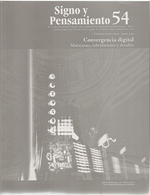Abstract
EMedia convergence is a process which is made easier by means of the extended implementation of communication digital technologies, which in turn shape very different routines and allows for the integrated incorporation of tools, spaces, working methods, and languages previously unconnected. Convergence usually develops in at least five areas: technology, business, content, users, and the media professionals. This article explores the strengths and weaknesses that the communication sector faces as a result of the growth of digital convergence in each of those areas. Finally, a series of recommendations are put forward in order to maintain and strengthen the principles of public service, general interest, and universal access to the convergence scenario.
Benavides, J. et al. (eds.) (2000), Las convergencias de la comunicación. Problemas y perspectivas investigadoras, Madrid, Fundación General Universidad Complutense.
Bustamante, E. (comp.) (2002). Comunicación y cultura en la era digital. Industrias, mercados y diversidad en España, Barcelona, Gedisa.
Castells, M. (2001), La galaxia Internet. Reflexiones sobre Internet, empresa y sociedad, Barcelona, Plaza & Janés.
Cebrián Herreros, M. (2001), La radio en la convergencia multimedia, Barcelona, Gedisa.
Christensen, C. M. (2000), The Innovators Dilemma: When New Technologies Cause Great Firms to Fail, Cambridge, Harvard Business School Press.
De Sola Pool, I. (1983), Technologies of Freedom, Cambridge, MA, Belknap Press.
EGEDA (2008), Panorama audiovisual 2007, Madrid, EGEDA.
García Avilés, J. A.; Salaverría, R., y Masip, P. (2008), “Convergencia periodística en los medios de comunicación. Propuesta de definición conceptual y operativa”, en: I Congreso de la Asociación Española de Investigadores en Comunicación, Santiago de Compostela.
García Avilés, J. A. y Carvajal, M. (2008), “Integrated and Cross-Media Newsroom Convergence: Two Models of Multimedia News Production: The Cases of Novotécnica and La Verdad Multimedia in Spain”, en: Convergence, vol. 2, núm. 14, pp. 223-241.
García Avilés, J. A. (2006), El periodismo audiovisual ante la convergencia digital, Alicante, Editorial Universidad Miguel Hernández.
Jenkins, H. (2006), Convergence Culture. Where Old and New Media Collide, Nueva York, New York University Press.
León, B. y García Avilés, J. A. (2000), “La información audiovisual interactiva en el entorno de convergencia digital: desarrollo y rasgos distintivos”, en: Comunicación y sociedad, vol. XII, núm. 2, pp. 141-179.
— (2002), “Los retos de la implantación de la televisión interactiva a la luz de su propia historia”, en: Zer. Revista de Estudios de Comunicación [en línea], núm. 13, disponible en: http://www.ehu.es/zer/zer13/retos13.htm, recuperado: 5 de junio 2008.
Prado, E. y Franquet, R. (1998, mayo), “Convergencia digital en el paraíso tecnológico: claroscuros de una revolución”, en: ZER, núm. 4, pp. 28-39.
Salaverría, R. y García Avilés, J. A. (2008), “La convergencia tecnológica en los medios de comunicación: retos para el periodismo”, Trípodos, núm. 23, pp. 31-47.
Stipp, H. (1999), “Convergence Now?”, en: The International Journal of Media Management, vol. 1, núm. 1.
Trejo Delarbre, R. (2008), “Iberoamérica: retos, rezagos y oportunidades en el umbral de la convergencia digital”, en: Ponencia III Acta Internacional de la Lengua Española. Una nueva era audiovisual y tecnológica, Huelva.
This journal is registered under a Creative Commons Attribution 4.0 International Public License. Thus, this work may be reproduced, distributed, and publicly shared in digital format, as long as the names of the authors and Pontificia Universidad Javeriana are acknowledged. Others are allowed to quote, adapt, transform, auto-archive, republish, and create based on this material, for any purpose (even commercial ones), provided the authorship is duly acknowledged, a link to the original work is provided, and it is specified if changes have been made. Pontificia Universidad Javeriana does not hold the rights of published works and the authors are solely responsible for the contents of their works; they keep the moral, intellectual, privacy, and publicity rights.
Approving the intervention of the work (review, copy-editing, translation, layout) and the following outreach, are granted through an use license and not through an assignment of rights. This means the journal and Pontificia Universidad Javeriana cannot be held responsible for any ethical malpractice by the authors. As a consequence of the protection granted by the use license, the journal is not required to publish recantations or modify information already published, unless the errata stems from the editorial management process. Publishing contents in this journal does not generate royalties for contributors.


